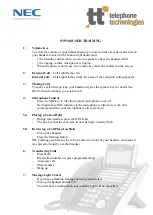
Infrastructure Requirements and Layout Planning
LTE 700 MHz MobileAccessVE Instant Coverage Solution User Manual
10
3
Infrastructure Requirements and Layout
Planning
3.1
General Information on Location and Connections
Service provider’s RF equipment - macrocell, microcell, picocell, femtocell, BDA, etc. connects
to the VCU through a passive interface.
VCUs:
Master VCU installed at the main IDF/Telco cabinet and connected to all VCUs.
Slave VCUs installed at the IDF/Telco cabinet of each covered floor and connected to the
Master VCU, the Ethernet switch, and the VAPs through the cabling patch panel.
Wireless service signals from Master VCU to VCUs – Routed through dedicated Ethernet CAT-
6/7 cabling.
Wireless service signals from VCUs to the VAPs – Routed through existing Ethernet CAT-5e/6
cabling infrastructure.
VAP location and mounting. Connection to existing Ethernet jack and external antennas.
VAP power source - No power connections required. VAPs are power fed from VCU using PoE
(Power over Ethernet) technology.
Figure 3-1. VE Multi-Tier Basic Architecture
Note: connecting both VAPs and slave VCUs simultaneously to the master VCU is supported
for VE networks running SW version 2.6 and above.
Note: If the Master VCU supports VAPs (in
addition to VCUs), the relevant Ethernet ports
are also connected to an Ethernet switch.
















































